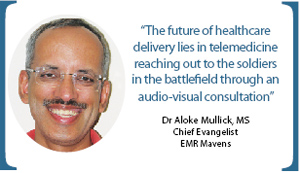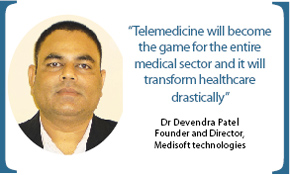
The integration of ICT into the health sector has globally empowered the status of health in recent years
By Shally Makin

Telemedicine dates back to the 1990s when the technology was first used to communicate through telephone, facsimile machine, and slow-scan images. The advent of communication technology, especially Satellite Communications (SatCom) combined with information technology, has infused life into the industry of telemedicine.
The word telemedicine basically defines ‘the use of telecommunication technology for medical diagnosis, treatment and patient care’. It is the exchange of medical information via electronic communication such as interactive audio-visual intending towards improving patient’s health. The solution consists of a well equipped system of medical software integrated with medical diagnostic instruments connected to the commercial VSAT (Very Small Aperture Terminal) at each location or fibre optics. Dr Devendra Patel, Founder and Director, Medisoft Technologies, defines telemedicine as, “a patient centric healthcare delivery model. In other words, it means, putting the power directly in the hands of the patients by harnessing the power of the World Wide Web.”
The global market of telemedicine is forecasted to reach US $13.9 billion by 2012. The market of telemedicine in India is expected to grow by 21 percent till 2014. With a 700 million rural population, India is in a need of a highly networked digital data transmission process for a better health infrastructure. Telemedicine proves to be a boon for an ailing patient, who needs super-specialty opinion.

 Dr AC Mullick, MS, Chief Evangelist, EMR Mavens says, “Telemedicine moves the information and not the patient. Tele-connected healthcare systems now offer primary healthcare clinic chains with video consultation for travelling patients via hosted applications, right here in India.” He adds, “Patients discharged after major procedures are being remotely monitored at home with next generation tele-health platforms in the US, and this will soon happen in India too. The technology has matured enough to be disruptive and has the potential to change the basic paradigms of healthcare delivery. The future is here.”
Dr AC Mullick, MS, Chief Evangelist, EMR Mavens says, “Telemedicine moves the information and not the patient. Tele-connected healthcare systems now offer primary healthcare clinic chains with video consultation for travelling patients via hosted applications, right here in India.” He adds, “Patients discharged after major procedures are being remotely monitored at home with next generation tele-health platforms in the US, and this will soon happen in India too. The technology has matured enough to be disruptive and has the potential to change the basic paradigms of healthcare delivery. The future is here.”
The tech savvy world has transformed the way healthcare is delivered to the masses. In India, there are presently 700 million mobile users, out of which 35 percent of them use smart phones. Today, if people are ready to shell out `200 a month to receive cricket info, then most of the health conscious people would be happy to know the health tips being received on their phones as a new service being introduced. The 3G phones being popular nowadays serve as an important device to share health reports, x-rays and photos with doctors and specialists for advice and treatment options, through the new telecommunication technology. The use of telemedicine in treating soldiers posted at borders will also become a reality in the near future. Dr AC Mullick adds, “Severe battlefield injury patients on the frontline are remotely monitored by specialists in base hospitals via secure mobile tele-health systems in the Iraqi battlefield.” This is a fair example of how healthcare delivery systems have transformed into.
 Dr Devendra Patel adds, “Telemedicine has a broader spectrum than what appears first hand. In its simplest form it can be represented by a telephonic conversation between a patient and a medical practitioner. At the other extreme end, telemedicine can mean a robotic surgery being performed remotely.” So far, telemedicine is implemented in orthopaedics, dermatology, psychiatry, oncology, neurology, paediatrics, internal medicine, ophthalmology and surgery.
Dr Devendra Patel adds, “Telemedicine has a broader spectrum than what appears first hand. In its simplest form it can be represented by a telephonic conversation between a patient and a medical practitioner. At the other extreme end, telemedicine can mean a robotic surgery being performed remotely.” So far, telemedicine is implemented in orthopaedics, dermatology, psychiatry, oncology, neurology, paediatrics, internal medicine, ophthalmology and surgery.
 Dr Arjun Kalyanpur, CEO and Chief Radiologist, Teleradiology solutions says, “Teleradiology has proved to be the feather in the cap of telemedicine, as it provides a real-life success story of what telemedicine can achieve, with the right focus on appropriate technology and process.”
Dr Arjun Kalyanpur, CEO and Chief Radiologist, Teleradiology solutions says, “Teleradiology has proved to be the feather in the cap of telemedicine, as it provides a real-life success story of what telemedicine can achieve, with the right focus on appropriate technology and process.”
Since telecommunication has now become the primary source of communication, in the coming years, telemedicine has a great scope of development. Use of phones and internet is now an affordable source of communication. Thus, it prospects to improve the quality, increases the efficiency and expands the access of the healthcare delivery system to the rural population and developing countries.
A ubiquitous wireless technology helps the transfer of the patient’s condition virtually to a doctor far away from the site. This not only saves time but promises to greatly improve the cost and convenience associated with long-term outpatient monitoring. Dr Arjun Kalyanpur believes that the role of telemedicine should therefore no longer be a subject of discussion or debate, but rather it needs to be rapidly implemented on a large scale within the healthcare enterprise, and rightfully recognized as one of the key enablers of healthcare delivery. Telemedicine is a way to reach out to peoples’ home rather than encouraging them to go to doctors for health related advices.
Be a part of Elets Collaborative Initiatives. Join Us for Upcoming Events and explore business opportunities. Like us on Facebook , connect with us on LinkedIn and follow us on Twitter , Instagram.


